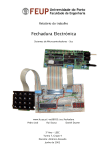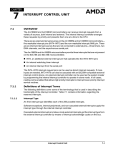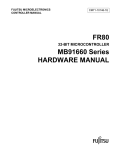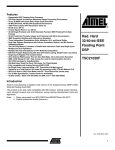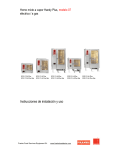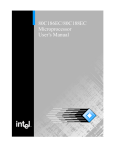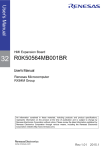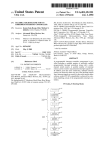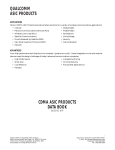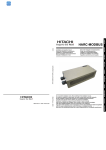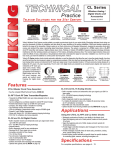Download Understanding the Interrupt Control Unit of the 80C186EC
Transcript
A AP-731 APPLICATION NOTE Understanding the Interrupt Control Unit of the 80C186EC/80C188EC Processor Sean Kohler Application Engineer Intel Corporation 5000 West Chandler Boulevard Chandler, AZ 85226 March 13, 1996 Order Number: 272823-001 Information in this document is provided in connection with Intel products. Intel assumes no liability whatsoever, including infringement of any patent or copyright, for sale and use of Intel products except as provided in Intel’s Terms and Conditions of Sale for such products. Intel retains the right to make changes to these specifications at any time, without notice. Microprocessor products may have minor variations to this specification known as errata. *Other brands and names are the property of their respective owners. Contact your local Intel sales office or your distributor to obtain the latest specifications before placing your product order. Copies of documents which have an ordering number and are referenced in this document, or other Intel literature, may be obtained from: Intel Corporation Literature Sales P.O. Box 7641 Mt. Prospect, IL 60056-7641 or call 1-800-548-4725 COPYRIGHT © INTEL CORPORATION, 1996 A Contents Understanding the Interrupt Control Unit of the 80C186EC/80C188EC Processor 1.0 INTRODUCTION ........................................................................................................................................1 2.0 OVERVIEW ................................................................................................................................................2 3.0 INTERRUPT PROCESSING ......................................................................................................................2 4.0 82C59A PROGRAMMING .........................................................................................................................3 4.1 ICW Initialization Sequence ................................................................................................................3 4.2 Initialization Command Words ............................................................................................................5 4.2.1 ICW1 Beginning of Initialization Register .................................................................................5 4.2.2 ICW1 Access ...........................................................................................................................6 4.2.3 ICW2 Base Interrupt Type Register .........................................................................................6 4.2.4 ICW2 Access ...........................................................................................................................6 4.2.5 ICW3 Cascaded Input Selection/Slave ID ................................................................................7 4.2.6 ICW3 Access ...........................................................................................................................7 4.2.7 ICW4 Special Fully Nested Mode/ Automatic End of Interrupt Mode Register ........................7 4.2.8 ICW4 Access ...........................................................................................................................7 4.3 Operational Command Words ............................................................................................................7 4.3.1 OCW1 Interrupt Mask Register ................................................................................................7 4.3.2 OCW1 Access ..........................................................................................................................7 4.3.3 OCW2 Priority and EOI Register ..............................................................................................7 4.3.4 OCW2 Access ..........................................................................................................................8 4.3.5 OCW3 Special Mask Mode and Read Register Selection .......................................................8 4.3.6 OCW3 Access ..........................................................................................................................8 5.0 RELATED INFORMATION .........................................................................................................................8 APPENDIX A Software Examples ............................................................................................................. A-1 A.1 Initialization Sequence and ISR Examples ..................................................................................... A-1 A.2 ISR for Unexpected or Uninitialized Interrupts ............................................................................... A-9 FIGURES Figure 1. Interrupt Control Unit Block Diagram ........................................................................................ 1 Figure 2. Initialization Sequence of the ICW Registers............................................................................ 4 TABLES Table 1. A1 Address Line Connections ................................................................................................... 5 Table 2. Related Information ................................................................................................................... 8 EXAMPLES Example A-1. Initialization Sequence and ISR Examples ............................................................................ A-1 Example A-2. ISR for Unexpected or Uninitialized Interrupts ....................................................................... A-9 iii A INTRODUCTION The Intel 186 processor core has two external interrupt sources; the Non-Maskable Interrupt (NMI) and a maskable interrupt source (INTR). The NMI input of the core is brought directly out to the NMI pin. For most embedded designs, a single maskable interrupt input is not sufficient. In order to expand the capabilities of the single maskable interrupt an interrupt controller is needed. Most of the 186 embedded processor proliferations use a proprietary interrupt controller to expand the number of available maskable interrupts. Unlike other members of the 186 family of embedded microprocessors, the 80C186EC/80C188EC processor uses an 82C59A compatible interrupt control unit instead of a proprietary interrupt controller. (The 82C59A is an industry standard interrupt controller for embedded and PCcompatible solutions.) Two 82C59A compatible programmable interrupt controllers (PIC) are located on the 80C186EC/80C188EC processor die. One PIC is configured as the master while the other is configured as a slave. The slave is connected to IR7 of the master. See Figure 1. Master 8259A IR0 IR1 IR2 IR3 IR4 IR5 IR6 IR7 INT INTA D7:0 Slave 8259A INT IR0 IR1 IR2 IR3 IR4 IR5 IR6 IR7 Internal Control Bus CAS2 CAS1 CAS0 Internal Interrupt Request Latch Registers INTA D7:0 A0 A1 CAS2 CAS1 CAS0 TMI0 TMI1 DMA12 DMA13 TMI2 RXI0 TXI0 INT7 A1 A0 Internal Address Bus INT0 INT1 INT2 INT3 INT4 INT5 INT6 INT7 Internal Data Bus (F-Bus) 1.0 AP-731 CAS Bus Interrupt Requests From Integrated Peripherals Figure 1. Interrupt Control Unit Block Diagram 1 A AP-731 The 82C59A has eight interrupt request lines. By cascading additional 82C59As, up to 64 interrupt request lines can be supported. Each cascaded 82C59A is called a slave; there can be only one master. The master PIC of the 80C186EC/80C188EC processor prioritizes interrupt requests from attached slaves and IR lines and presents requests, one at a time, to the single maskable interrupt line of the processor core. 3.0 When an interrupt occurs, several steps are taken by the processor: 1. A partial machine status is saved/copied by pushing the Program Status Word (PSW) onto the stack. 2. The Trap Flag (TF) bit and the Interrupt Enable Flag (IF) bit are cleared in the PSW. This application note contains: • A step-by-step description of the interrupt processing sequence. • A description of subtleties programming 82C59A registers. associated This prevents maskable interrupts or single step exceptions from interrupting the processor during the ISR. While in the ISR: with This application note is meant to be used in conjunction with the 80C186EC/80C188EC Microprocessor User’s Manual. Refer to the User’s Manual for a complete explanation of the operation of 82C59A registers. 2.0 OVERVIEW The 80C186EC/80C188EC processor can detect up to 256 different interrupts. Each interrupt is specified by its interrupt type ranging from 0 to 255. Each interrupt type has a corresponding interrupt vector, which is the interrupt type multiplied by 4. A vector is a double word pointer that points to the associated Interrupt Service Routine (ISR). An interrupt vector table in memory stores up to 256 interrupt vectors. The first word of the vector contains the offset of the associated ISR while the second word contains the segment. This makes each vector a total of 4 bytes. The interrupt vector table is located at the base of the processor’s memory map, at 0000:0000. The interrupt vector table is 1 Kbyte in length (4 bytes multiplied by 256 types) and therefore goes up to 0000:03FF. Because of the location of the interrupt vectors, the lower 1 Kbyte of memory space should be reserved for interrupt vectors. 2 INTERRUPT PROCESSING • To nest interrupts, set the IF bit in the PSW by issuing an STI instruction. • To use single stepping inside an ISR, push/copy the PSW onto the stack using the PUSHF instruction, modify the copy of the PSW on the stack to set the TF bit and then restore the PSW by popping the altered copy off of the stack using POPF. 3. The current CS and IP are pushed onto the stack. 4. The interrupt controller passes the interrupt type to the processor. The processor multiplies the interrupt type by 4 to yield the base address of the associated interrupt vector. The processor reads a word from that address and loads it into the IP register. It then reads the next word at the interrupt vector address plus 2 and loads the value into the CS register. The processor begins executing code at the new location specified by CS and IP. This location is the ISR associated with the particular interrupt. A AP-731 Upon completion of the ISR, the programmer must take several steps: 4.0 1. 4.1 When the interrupt comes from one of the request lines of the PIC (not an exception), clear the In-Service bit for that interrupt source by issuing an end of interrupt command (EOI). When the interrupt source is a slave PIC, clear the master’s In-Service bit, then clear the slave’s InService bit. 2. Issue an IRET instruction. When an IRET instruction is executed, the processor takes the following steps: 1. Restores the CS and IP by popping the copies off the stack. 2. Restores the PSW by popping its copy off the stack. 3. Executes instructions at the address that the CS and IP point to (where the processor left off before the interrupt occurred). The stack is used to store the pre-interrupt flag status and pre-interrupt program execution location. It is important to locate and allocate the stack such that data/code corruption does not occur during execution of single and nested interrupts. 82C59A PROGRAMMING ICW Initialization Sequence Before normal operation can begin, each 82C59A must be initialized by a sequence of two to four programming bytes called Initialization Command Words (ICWs). After reset, the states of all the 82C59A registers are undefined. The ICWs are used to set up the necessary conditions and modes for proper 82C59A operation. Minimum 82C59A initialization requires at least ICW1 and ICW2 to be configured. ICW3 and ICW4 are used only if designated in ICW1. The details of the function of each register are described in the 80C186EC/80C188EC Microprocessor User’s Manual. NOTE: The ICW initialization sequence is started (or restarted) at ICW1 by writing data to master port MPICP0 or slave port SPICP0 with the data bit position 4 set to a 1. Figure 2 illustrates the initialization sequence of the ICW registers. The sequence in which these registers are programmed is critical. Once the 82C59A is initialized, any changes to the ICWs are made by restarting the sequence. If the sequence is interrupted, the state machine can be reinitialized by writing to ICW1. 3 A AP-731 ICW1 ICW2 No In Cascade Mode ? Yes SNGL=1 ICW3 No IC4=0 Is ICW4 Needed ? Yes ICW4 Ready to Accept Interrupt Requests A4327-01 Figure 2. Initialization Sequence of the ICW Registers 4 A AP-731 Once the initialization sequence begins (ICW1 has been accessed), the 82C59A automatically performs the following events: • • Table 1. A1 Address Line Connections Port Name PCB Offset A1 of Processor A0 of 82C59A MPICP0 00 0 MPICP1 02 1 SPICP0 04 0 SPICP1 06 1 The edge sense circuit is reset, which makes low to high transitions on the interrupt request (IR) line necessary for a valid interrupt. The interrupt mask register is cleared to allow interrupts on all IR lines to be processed. Since initialization is not yet completed, it is strongly recommended that all maskable interrupts be masked during initialization by issuing a CLI instruction. The CLI instruction masks off the single maskable interrupt source on the 8086 enhanced core. Since the 82C59A presents interrupt requests via the single maskable interrupt input, any request coming through any of the PICs will be masked when the CLI instruction is executed. Once initialization is complete, an STI instruction can be used to enable interrupts. • IR7 input is assigned the highest priority. • The slave mode address is set to 7. • Special Mask Mode is cleared and Status Read is set to IRR. The first character of the port name indicates which internal 82C59A port is referenced: “M” indicates the Master PIC and “S” indicates the Slave. 4.2 Initialization Command Words The Initialization Command Words (ICWs) are programmed in a sequential format and are used to set up the integrated interrupt controller to an initial state of operation. Typically, the ICW registers are programmed only once and are left untouched for the duration of the application. This section highlights some of the subtleties associated with the functionality of each register and with accessing each register. NOTE: For the 80C186EC processor, the SNGL bit should always be cleared (leading to initialization of ICW3) and the IC4 bit should always be set (leading to initialization of ICW4). The complex initialization sequence exists because the original 8259 was designed with only one address line. Without the use of an initialization sequence (state machine), a device with only one address line would be able to access only two registers (ports). By implementing an initialization sequence, designers could keep the chip small and still access more than two registers (using only one address line). Write accesses to the Initialization Command Words of the 82C59A are controlled by the following: • The state of the A0 line of the 82C59A (which port being accessed) • The data written to the register • The sequence in which the data is written The A0 line of the 82C59A is connected to the A1 address line of the 80C186EC/80C188EC processor. See Table 1. 4.2.1 ICW1 Beginning of Initialization Register ICW1 is used to select level or edge sensitive triggering on the IRQ lines, the number of 82C59As in the system and to indicate whether or not the ICW4 register is used in the initialization sequence. NOTE: Mixed mode triggering is not possible. Either all of IR0 through IR7 is level triggered or edge triggered, but not both. There are some subtle differences between edge and level sensitive interrupts. If an IRQ line is configured as level sensitive and is left asserted while it is serviced, the processor immediately vectors back into the ISR once the EOI is issued. Therefore, if configured as level sensitive, the IR line must be deasserted before issuing the EOI command inside the ISR. If the IR line is configured as edge sensitive, the processor will not vector back into the ISR if the IR line is kept asserted once the EOI has been issued. In order for another interrupt to occur on a edge sensitive IR line, the line must be brought to its inactive state for 100 ns to reset the edge detection circuitry. 5 A AP-731 4.2.2 ICW1 Access ICW1 is a write-only register that is accessed through MPICP0 or SPICP0 with data bit position 4 set. See “ICW Initialization Sequence” on page 3 for more details. 4.2.3 ICW2 Base Interrupt Type Register The data written to this register corresponds to the base interrupt type. The base interrupt type is synonymous with the interrupt type for IR0. Once the base type has been defined each subsequent IRn line will have a TYPE = BASE + n. The interrupt vectors for each IR line will be at the location TYPE*4 in memory. When an IR line is configured as a cascaded input, it still has an associated type (interrupt vector), but in most cases, it is not used. There is a case in which an IR line configured as Cascade Mode still uses its corresponding interrupt vector. This special case exists when IR7 is configured for Cascade mode and it is also used for spurious interrupt detection. If any IR line is asserted and is deasserted before the falling edge of the first interrupt acknowledge pulse, then a special interrupt called a “spurious interrupt” is generated. The 82C59A detects these spurious interrupts when an IR line is asserted in this manner, and generates an interrupt of type IR7. The only difference between a true IR7 interrupt and an interrupt caused by a spurious interrupt detection is the fact that when a spurious interrupt is acknowledged, the InService bit for IR7 is never set. Spurious interrupt detection is useful in noisy environments where unwanted glitches might be interpreted as valid interrupt assertions. If IR7 is configured for Cascade mode then an interrupt of type IR7 can occur if a spurious interrupt was detected on one of the IRn lines of the PIC. If configured for Cascade 6 mode and a spurious interrupt does occur, a typical IR7 ISR (spurious interrupt ISR) simply returns control back to the main program by issuing an IRET instruction. See Appendix A for details If IR7 is being used and it is not configured in Cascade Mode, then there are two possibilities for an interrupt of type IR7 to occur: • A valid IR7 interrupt occurred • A spurious interrupt was detected on one of the IRn lines of the PIC If not configured for Cascade mode, once inside the IR7 ISR, software must examine the In-Service register to determine what event caused the processor to enter the ISR. If the In-Service bit for IR7 is set, then a valid IR7 interrupt occurred. If the In-Service bit is not set, then a spurious interrupt must have occurred on one of the eight IR lines of the PIC. Once the software has determined that it is inside the IR7 ISR because of a spurious interrupt, most ISRs just issue an IRET instruction to return control back to the main program. If the processor is inside the IR7 ISR because of a valid interrupt, the interrupt is serviced, its In-Service bit is cleared by issuing a End of Interrupt (EOI) then finally the ISR is completed and control returned back to the main program by issuing a IRET instruction. See Appendix A for an example. 4.2.4 ICW2 Access ICW2 is a write-only register which is accessed by a write to MPICP1 or SPICP1 immediately after ICW1 has been configured. See “ICW Initialization Sequence” for more details. A 4.2.5 AP-731 ICW3 Cascaded Input Selection/Slave ID ICW3 of the master is used to select whether or not a slave will be connected to the associated IR line. ICW3 of a slave is used to set the associated slave ID. The slave ID should match the IR line number of the master that it is connected to. NOTE: Special precautions must be taken when connecting a slave to IR0 of a master 82C59A module. A slave programmed for an ID of zero will be active for both interrupts that it has requested, as well as for uncascaded master interrupts; uncascaded interrupts leave the cascade bus (CAS2:0) lines low. If this situation occurs there will be contention on the data bus, since both the master and the slave attempt to drive the interrupt type on the data bus. Never cascade a slave 82C59A module to IR0 of a master module unless IR0 is the last available uncascaded input (i.e., the system is fully cascaded with eight slave 82C59A modules). 4.2.6 ICW3 Access ICW3 is a write-only register. If the SNGL bit of ICW1 was cleared during the initialization sequence, ICW3 can be accessed by a write to MPCIP1 or SPCIP1 immediately after ICW2 has been initialized. See “ICW Initialization Sequence” for more details. 4.2.7 ICW4 Special Fully Nested Mode/ Automatic End of Interrupt Mode Register 4.3 Once the 82C59A has been initialized using the ICWs, the Operational Command Words (OCWs) can be used to modify priority schemes, End of Interrupt (EOI) configurations and interrupt masking. Three OCWs are available for programming but, unlike the ICWs, the OCW registers can be accessed in any order. These registers can be accessed whenever the programmer desires, provided that the ICWs have been previously initialized. Although there is no accessing sequence to the OCWs, accessing each OCW and accompanying register (described later) is not intuitive. A detailed description of the OCW registers is given in the 80C186EC/80C188EC Microprocessor User’s Manual. This section highlights some of the subtleties associated with the function of each register and with accessing each register. 4.3.1 4.2.8 OCW1 Interrupt Mask Register OCW1 is the interrupt mask register. Setting a bit in the mask register disables the corresponding interrupt request on the associated IR line. It is important to note that if the IR line is asserted while it is masked, the associated interrupt request bit will be set, but the interrupt will never be presented to the processor core because it is masked. If an IR line is unmasked while the interrupt request bit is set, the interrupt request will be presented to the processor core. Therefore, it is important to clear the associated interrupt request bit when masking and unmasking interrupts. The interrupt request bit can be cleared by reading the interrupt request register (see “OCW3 Special Mask Mode and Read Register Selection”). 4.3.2 ICW4 is a write-only register. Special Fully Nested (SFN) Mode and Automatic End of Interrupt (AEOI) Mode are selected using ICW4. Operational Command Words OCW1 Access OCW1 is accessed by read or writes to SPICP1 or MPICP1 provided that the ICW initialization sequence has been completed. ICW4 Access 4.3.3 ICW4 is accessed by a write to MPICP1 or SPICP1 provided that the IC4 bit was set in ICW1 during the initialization sequence. See “ICW Initialization Sequence” for more details. OCW2 Priority and EOI Register OCW2 is used to set interrupt priority schemes and various End of Interrupt (EOI) configurations. A detailed description of its operation is in the 80C186EC/80C188EC Microprocessor User’s Manual. 7 A AP-731 4.3.4 OCW2 Access OCW2 is a write only register that is accessed by writes to MPICP0 or SPICP0 with data bit position 3 and 4 cleared provided that the ICW initialization sequence has been completed. 4.3.5 OCW3 Special Mask Mode and Read Register Selection OCW3 is used to control Special Mask Mode, Poll Mode and read register selection. A detailed explanation is given in the 80C186EC/80C188EC Microprocessor User’s Manual. Setting the ERR bit in conjunction with either clearing or setting the RSEL bit determines which register is accessed through a read cycle to the MPICP0 or SPICP0 port. • • The In-Service register is an 8-bit register containing the priority levels that are being serviced. The In-Service register is updated when an End of Interrupt (EOI) command is issued. Once the In-Service bit is set, assertions to the corresponding IR line will be ignored until it is cleared (by issuing an EOI). The Interrupt Request register is an 8-bit register containing the priority of the interrupts waiting to be acknowledged. The highest request level is reset from the Interrupt Request register when an interrupt is acknowledged. 4.3.6 OCW3 Access OCW3 is a write only register that is accessed by writing to MPICP0 or SPICP0 with data bit position 3 set and data bit positions 4 and 7 cleared. If the OCW3 register is written to and the RSEL bit is set in conjunction with the ERR bit, then a read to either MPICP0 or SPICP0 will be a read to the InService register. 5.0 If the OCW3 register is written to and the RSEL bit is cleared in conjunction with the ERR bit, then a read to either MPICP0 or SPICP0 will be a read to the Interrupt Request register. To order printed Intel literature, contact: The RSEL bit can only be modified when the ERR bit is set. RELATED INFORMATION Intel offers a variety of information through the World Wide Web at http://www.intel.com. Intel Corporation Literature Fulfillment P.O. Box 7641 Mt. Prospect, IL 60056-7641 1-800-548-4725 Table 2. Related Information Document Name Order # 80C186EC/80C188EC Microprocessor User’s Manual 272047 Embedded Microprocessors Databook see the 80C186EC/80C188EC and 80L186EC/80L188EC 16-Bit High-Integration Embedded Processors datasheet 272396 Peripheral Components Databook see the 82C59A-2 CHMOS Programmable Interrupt Controller datasheet 296467 8 A A.1 AP-731 APPENDIX A Software Examples Initialization Sequence and ISR Examples This software example illustrates interrupt vector initialization, basic interrupt controller initialization sequence and simple interrupt service routines. This software was assembled using Intel ASM86 and was tested using the Intel EV80C186EC evaluation board REV 1.1. Example A-1. Initialization Sequence and ISR Examples (Sheet 1 of 8) $ TITLE (82C59 Programming Example) $ MOD186 NAME ICU_DEMO $INCLUDE (C:\EV186EC\ECPCB.INC) ;INCLUDE PERIPHERAL CONTROL BLOCK REGISTER MAP _7SEG1 _7SEG2 EQU EQU 1000H 1010H ;7 SEGMENT #1 I/O ADDRESS ;7 SEGMENT #2 I/O ADDRESS ZERO ONE TWO THREE FOUR FIVE SIX SEVEN PATTERN1 PATTERN2 EQU EQU EQU EQU EQU EQU EQU EQU EQU EQU 03FH 06H 05BH 04FH 066H 06DH 07CH 07H 064H 052H ;BIT MAPS FOR 7 SEG DISPLAY MASTER_BASE_TYPE SLAVE_BASE_TYPE EQU EQU 96 104 ;TYPE*4 = BASE ADDR OF MASTER ;TYPE*4 = BASE ADDR OF SLAVE ;IDENTIFIES SPURIOUS INTERRUPT ON MASTER ;IDENTIFIES SPURIOUS INTERRUPT ON SLAVE ;SEE FIGURE 8-1 OF THE 80C186EC/80C188EC USER’S MANUAL INT0_TYPE INT1_TYPE INT2_TYPE INT3_TYPE INT4_TYPE INT5_TYPE INT6_TYPE INT7_TYPE SPM_TYPE EQU EQU EQU EQU EQU EQU EQU EQU EQU MASTER_BASE_TYPE MASTER_BASE_TYPE MASTER_BASE_TYPE MASTER_BASE_TYPE MASTER_BASE_TYPE MASTER_BASE_TYPE MASTER_BASE_TYPE SLAVE_BASE_TYPE MASTER_BASE_TYPE + + + + + + + + 1 2 3 4 5 6 7 7 A-1 A AP-731 Example A-1. Initialization Sequence and ISR Examples (Sheet 2 of 8) ;+++++++++++++++++++++++++++++++++++++++++++++++++++++++++++++++++++++++++++++++ ;CODE SEGMENT AT LOCATION 1000H WHICH IS IN THE SRAM OF THE EV80C186EC EVALUATION ;BOARD ;+++++++++++++++++++++++++++++++++++++++++++++++++++++++++++++++++++++++++++++++ EC_CODE SEGMENT AT 0100H ASSUME CS:EC_CODE ;PUT CODE IN SRAM OF EVALBOARD MAIN: CLI ;DISABLE INTERRUPTS CALL CLR_LEDS CALL SETVECT CALL INIT_ICU STI ;CLEAR 7SEG DISPLAYS ;INITIALIZE INTERRUPT VECTORS ;INITIALIZE INTERRUPT CONTROL UNIT ;ENABLE INTERRUPTS JMP $ ;WAIT FOR INTERRUPTS ;+++++++++++++++++++++++++++++++++++++++++++++++++++++++++++++++++++++++++++++++ ;PROCEDURE: SETVECT ; ;THIS PROCEDURE INITIALIZES THE INTERRUPT VECTOR TABLE FOR EXTERNAL ;INTERRUPTS INT0-7 AND ALSO INTITIALIZES THE INTERRUPT VECTORS FOR SPURIOUS ;INTERRUPT DETECTION ;+++++++++++++++++++++++++++++++++++++++++++++++++++++++++++++++++++++++++++++++ SETVECT PROC XOR AX, AX MOV DS, AX ;CLEAR ACCUMULATOR ;CLEAR DATA SEGMENT ;SETUP INT0 INTERRUPT VECTOR MOV DI, INT0_TYPE*4 ;MOVE BASE ADDRESS OF INT0 VECTOR IN TO DI MOV WORD PTR DS:[DI], OFFSET INT0_ISR MOV WORD PTR DS:[DI+2], SEG INT0_ISR ;SETUP INT1 INTERRUPT VECTOR MOV DI, INT1_TYPE*4 ;MOVE BASE ADDRESS OF INT1 VECTOR IN TO DI MOV WORD PTR DS:[DI], OFFSET INT1_ISR MOV WORD PTR DS:[DI+2], SEG INT1_ISR ;SETUP INT2 INTERRUPT VECTOR MOV DI, INT2_TYPE*4 ;MOVE BASE ADDRESS OF INT2 VECTOR IN TO DI MOV WORD PTR DS:[DI], OFFSET INT2_ISR MOV WORD PTR DS:[DI+2], SEG INT2_ISR ;SETUP INT3 INTERRUPT VECTOR MOV DI, INT3_TYPE*4 ;MOVE BASE ADDRESS OF INT3 VECTOR IN TO DI MOV WORD PTR DS:[DI], OFFSET INT3_ISR MOV WORD PTR DS:[DI+2], SEG INT3_ISR ;SETUP INT4 INTERRUPT VECTOR A-2 A AP-731 Example A-1. Initialization Sequence and ISR Examples (Sheet 3 of 8) MOV DI, INT4_TYPE*4 ;MOVE BASE ADDRESS OF INT4 VECTOR IN TO DI MOV WORD PTR DS:[DI], OFFSET INT4_ISR MOV WORD PTR DS:[DI+2], SEG INT4_ISR ;SETUP INT5 INTERRUPT VECTOR MOV DI, INT5_TYPE*4 ;MOVE BASE ADDRESS OF INT5 VECTOR IN TO DI MOV WORD PTR DS:[DI], OFFSET INT5_ISR MOV WORD PTR DS:[DI+2], SEG INT5_ISR ;SETUP INT6 INTERRUPT VECTOR MOV DI, INT6_TYPE*4 ;MOVE BASE ADDRESS OF INT6 VECTOR IN TO DI MOV WORD PTR DS:[DI], OFFSET INT6_ISR MOV WORD PTR DS:[DI+2], SEG INT6_ISR ;SETUP INT7 INTERRUPT VECTOR (ALSO THE INTERRUPT VECTOR FOR SPURIOUS ;INTERRUPT DETECTION FOR THE SLAVE) MOV DI, INT7_TYPE*4 ;MOVE BASE ADDRESS OF INT7 VECTOR IN TO DI MOV WORD PTR DS:[DI], OFFSET INT7_ISR MOV WORD PTR DS:[DI+2], SEG INT7_ISR ;SETUP SPURIOUS INTERRUPT VECTOR FOR MASTER MOV DI, SPM_TYPE*4 ;MOVE BASE ADDRESS OF IR7 OF MASTER VECTOR TO DI MOV WORD PTR DS:[DI], OFFSET SPM_ISR MOV WORD PTR DS:[DI+2], SEG SPM_ISR RET SETVECT ENDP ;+++++++++++++++++++++++++++++++++++++++++++++++++++++++++++++++++++++++++++++++ ;INTERRUPT SERVICE ROUTINE: INT0_ISR ; ;THIS PROCEDURE WILL DISPLAY A ‘O’ ON THE 7 SEGMENT DISPLAY IF INT0 WAS ASSERTED ;+++++++++++++++++++++++++++++++++++++++++++++++++++++++++++++++++++++++++++++++ INT0_ISR PROC MOV DX, _7SEG1 MOV AL, ZERO OUT DX, AL ;DISPLAY ‘O’ ON 7 SEGMENT DISPLAY MOV DX, MPICP0 MOV AL, 20H OUT DX, AL ;CLEAR IN-SERVICE BIT BY ISSUING EOI IRET INT0_ISR ENDP A-3 A AP-731 Example A-1. Initialization Sequence and ISR Examples (Sheet 4 of 8) ;+++++++++++++++++++++++++++++++++++++++++++++++++++++++++++++++++++++++++++++++ ;INTERRUPT SERVICE ROUTINE: INT1_ISR ; ;THIS PROCEDURE WILL DISPLAY A ‘1’ ON THE 7 SEGMENT DISPLAY IF INT1 WAS ASSERTED ;+++++++++++++++++++++++++++++++++++++++++++++++++++++++++++++++++++++++++++++++ INT1_ISR PROC MOV DX, _7SEG1 MOV AL, ONE OUT DX, AL ;DISPLAY ‘1’ ON 7 SEGMENT DISPLAY MOV DX, MPICP0 MOV AL, 20H OUT DX, AL ;CLEAR IN-SERVICE BIT BY ISSUING EOI IRET INT1_ISR ENDP ;+++++++++++++++++++++++++++++++++++++++++++++++++++++++++++++++++++++++++++++++ ;INTERRUPT SERVICE ROUTINE: INT2_ISR ; ;THIS PROCEDURE WILL DISPLAY A ‘2’ ON THE 7 SEGMENT DISPLAY IF INT2 WAS ASSERTED ;+++++++++++++++++++++++++++++++++++++++++++++++++++++++++++++++++++++++++++++++ INT2_ISR PROC MOV DX, _7SEG1 MOV AL, TWO OUT DX, AL ;DISPLAY ‘2’ ON 7 SEGMENT DISPLAY MOV DX, MPICP0 MOV AL, 20H OUT DX, AL ;CLEAR IN-SERVICE BIT BY ISSUING EOI IRET INT2_ISR ENDP ;+++++++++++++++++++++++++++++++++++++++++++++++++++++++++++++++++++++++++++++++ ;INTERRUPT SERVICE ROUTINE: INT3_ISR ; ;THIS PROCEDURE WILL DISPLAY A ‘3’ ON THE 7 SEGMENT DISPLAY IF INT3 WAS ASSERTED ;+++++++++++++++++++++++++++++++++++++++++++++++++++++++++++++++++++++++++++++++ INT3_ISR PROC MOV DX, _7SEG1 MOV AL, THREE OUT DX, AL ;DISPLAY ‘3’ ON 7 SEGMENT DISPLAY MOV DX, MPICP0 MOV AL, 20H OUT DX, AL ;CLEAR IN-SERVICE BIT BY ISSUING EOI IRET INT3_ISR ENDP A-4 A AP-731 Example A-1. Initialization Sequence and ISR Examples (Sheet 5 of 8) ;+++++++++++++++++++++++++++++++++++++++++++++++++++++++++++++++++++++++++++++++ ;INTERRUPT SERVICE ROUTINE: INT4_ISR ; ;THIS PROCEDURE WILL DISPLAY A ‘4’ ON THE 7 SEGMENT DISPLAY IF INT4 WAS ASSERTED ;+++++++++++++++++++++++++++++++++++++++++++++++++++++++++++++++++++++++++++++++ INT4_ISR PROC MOV DX, _7SEG1 MOV AL, FOUR OUT DX, AL ;DISPLAY ‘4’ ON 7 SEGMENT DISPLAY MOV DX, MPICP0 MOV AL, 20H OUT DX, AL ;CLEAR IN-SERVICE BIT BY ISSUING EOI IRET INT4_ISR ENDP ;+++++++++++++++++++++++++++++++++++++++++++++++++++++++++++++++++++++++++++++++ ;INTERRUPT SERVICE ROUTINE: INT5_ISR ; ;THIS PROCEDURE WILL DISPLAY A ‘5’ ON THE 7 SEGMENT DISPLAY IF INT5 WAS ASSERTED ;+++++++++++++++++++++++++++++++++++++++++++++++++++++++++++++++++++++++++++++++ INT5_ISR PROC MOV DX, _7SEG1 MOV AL, FIVE OUT DX, AL ;DISPLAY ‘5’ ON 7 SEGMENT DISPLAY MOV DX, MPICP0 MOV AL, 20H OUT DX, AL ;CLEAR IN-SERVICE BIT BY ISSUING EOI IRET INT5_ISR ENDP ;+++++++++++++++++++++++++++++++++++++++++++++++++++++++++++++++++++++++++++++++ ;INTERRUPT SERVICE ROUTINE: INT6_ISR ; ;THIS PROCEDURE WILL DISPLAY A ‘6’ ON THE 7 SEGMENT DISPLAY IF INT6 WAS ASSERTED ;+++++++++++++++++++++++++++++++++++++++++++++++++++++++++++++++++++++++++++++++ INT6_ISR PROC MOV DX, _7SEG1 MOV AL, SIX OUT DX, AL ;DISPLAY ‘6’ ON 7 SEGMENT DISPLAY MOV DX, MPICP0 MOV AL, 20H OUT DX, AL ;CLEAR IN-SERVICE BIT BY ISSUING EOI IRET INT6_ISR ENDP A-5 A AP-731 Example A-1. Initialization Sequence and ISR Examples (Sheet 6 of 8) ;+++++++++++++++++++++++++++++++++++++++++++++++++++++++++++++++++++++++++++++++ ;INTERRUPT SERVICE ROUTINE: INT7_ISR ; ;THIS PROCEDURE WILL DISPLAY A ‘7’ ON THE 7 SEGMENT DISPLAY IF INT7 WAS ASSERTED ;OR WILL DISPLAY PATTERN2 IF A SPURIOUS INTERRUPT WAS DETECTED ON THE SLAVE ;+++++++++++++++++++++++++++++++++++++++++++++++++++++++++++++++++++++++++++++++ INT7_ISR PROC MOV DX, SPICP0 MOV AL, 0BH OUT DX, AL ;PREPARE TO READ IN-SERVICE REGISTER IN AL, DX ;READ FROM IN-SERVICE REGISTER TO DETERMINE ;IF VALID INTERRUPT OR SPURIOUS INTERRUPT CMP AL, 80H JZ IR7 ;CHECK TO SEE IF SPURIOUS OR NOT (10000000)=IR7 ;JUMP IF INTERRUPT WAS IR7 ASSERTION MOV DX, _7SEG1 MOV AL, PATTERN2 OUT DX, AL ;DISPLAY PATTERN2 ON 7 SEGMENT DISPLAY ;TO ILLUSTRATE SPURIOUS INTERRUPT HAS ;OCCURED ON SLAVE JMP DONE IR7: DONE: MOV DX, _7SEG1 MOV AL, SEVEN OUT DX, AL ;DISPLAY ‘7’ ON 7 SEGMENT DISPLAY MOV DX, SPICP0 MOV AL, 20H OUT DX, AL ;CLEAR IN-SERVICE BIT OF SLAVE BY ISSUING EOI MOV DX, MPICP0 MOV AL, 20H OUT DX, AL ;CLEAR IN-SERVICE BIT OF MASTER BY ISSUING EOI IRET INT7_ISR ENDP ;+++++++++++++++++++++++++++++++++++++++++++++++++++++++++++++++++++++++++++++++ ;INTERRUPT SERVICE ROUTINE: SPM_ISR ; ;THIS PROCEDURE WILL DISPLAY PATTERN1 ON THE 7 SEGMENT DISPLAY IF SPURIOUS ;INTERRUPT WAS DETECTED ON THE MASTER ;+++++++++++++++++++++++++++++++++++++++++++++++++++++++++++++++++++++++++++++++ SPM_ISR PROC MOV DX, _7SEG1 MOV AL, PATTERN1 OUT DX, AL IRET SPM_ISR ENDP A-6 ;DISPLAY PATTERN1 ON 7 SEGMENT DISPLAY ;TO ILLUSTRATE SPURIOUS INTERRUPT HAS ;OCCURRED ON MASTER PIC A AP-731 Example A-1. Initialization Sequence and ISR Examples (Sheet 7 of 8) ;+++++++++++++++++++++++++++++++++++++++++++++++++++++++++++++++++++++++++++++++ ;PROCEDURE: CLR_LEDS ;THIS PROCEDURE SIMPLY TURNS OFF ALL OF THE SEGMENTS THE 7 SEGMENT DISPLAY ;+++++++++++++++++++++++++++++++++++++++++++++++++++++++++++++++++++++++++++++++ CLR_LEDS PROC MOV DX, _7SEG1 XOR AL, AL OUT DX, AL MOV DX, _7SEG2 OUT DX, AL RET CLR_LEDS ENDP ;+++++++++++++++++++++++++++++++++++++++++++++++++++++++++++++++++++++++++++++++ ;PROCEDURE: INIT_ICU ;THIS PROCEDURE INITIALIZES THE INTERNAL MASTER AND SLAVE 82C59 OF THE ;80C186EC PROCESSOR ;+++++++++++++++++++++++++++++++++++++++++++++++++++++++++++++++++++++++++++++++ INIT_ICU PROC ;ALL OF THE INTERNAL PERIPHERAL INTERRUPT REQUEST LATCHES SHOULD ;BE CLEARED FOR SAFE MEASURE MOV MOV OUT MOV OUT MOV OUT DX, AX, DX, DX, DX, DX, DX, SCUIRL 0F00H AX TIMIRL AX DMAIRL AX ;INITIALIZE SLAVE 82C59 MODULE MOV XOR MOV OUT DX, AH, AL, DX, SPICP0 AH 11H AL ;ICW1 ->SPICP0 ;CLEAR RESERVED BITS ;EDGE TRIG, CASCADE, IC4 REQRD ;SET BASE INTERRUPT TYPE AT 104 FOR SLAVE MOV DX, SPICP1 ;ICW2 ->SPICP1 MOV AL, SLAVE_BASE_TYPE ;BASE ADDRESS AT 01A0H OUT DX, AL ;SLAVE ID MOV DX, SPICP1 ;ICW3 ->SPICP1 MOV AL, 7 ;ID=7 ALLWAYS FOR INTERNAL SLAVE OUT DX, AL MOV DX, SPICP1 MOV AL, 1 OUT DX, AL ;ICW4 ->SPICP1 ;NO SFNM, NO AEOI, FACTORY TEST CODES SET MOV DX, SPICP1 ;OCW1 ->SPICP1 A-7 A AP-731 Example A-1. Initialization Sequence and ISR Examples (Sheet 8 of 8) MOV AL, 07FH OUT DX, AL ;UNMASK INT7 (IR7 OF SLAVE) ;INITIALIZE MASTER MODULE MOV XOR MOV OUT DX, AH, AL, DX, MPICP0 AH 11H AL ;ICW1 ->MPICP0 ;EDGE TRIG, CASCADE, IC4 REQRD MOV DX, MPICP1 ;ICW2 ->MPICP1 MOV AL, MASTER_BASE_TYPE ;BASE TYPE FOR MASTER OUT DX, AL ;BASE ADDRESS AT 0180H ;SET BASE INTERRUPT TYPE FOR THE MASTER AT TYPE 96 ;WHICH IS EQUAVALENT TO A BASE ADDRESS OF 180H. BETWEEN ;THE BASE TYPES OF THE MASTER AND THE SLAVE, THERE IS A ;CONTIGUOUS BLOCK FROM 180H TO 1BCH FOR THE INTERRUPT VECTORS ;ADDRESS IR LINE TYPE FUNCTION 82C59 ;-----------------------------------------------------------;1BC 7 111 INT7 SLAVE ;1B8 6 110 TXI0 SLAVE ;1B4 5 109 RXI0 SLAVE ;1B0 4 108 TMI2 SLAVE ;1AC 3 107 DMAI3 SLAVE ;1A8 2 106 DMAI2 SLAVE ;1A4 1 105 TMI1 SLAVE ;1A0 0 104 TMI0 SLAVE ;19C 7 103 SLAVE MASTER ;198 6 102 INT6 MASTER ;194 5 101 INT5 MASTER ;190 4 100 INT4 MASTER ;18C 3 99 INT3 MASTER ;188 2 98 INT2 MASTER ;184 1 97 INT1 MASTER ;180 0 96 INT0 MASTER MOV DX, MPICP1 MOV AL, 80H OUT DX, AL ;ICW3 ->MPICP1 ;SLAVE MODULE IS ALWAYS ON IR7 MOV DX, MPICP1 MOV AL, 1 OUT DX, AL ;ICW4 ->MPICP1 ;NO SFNM, NO AEOI, FACTORY TEST CODES MOV DX, MPICP1 MOV AL, 0H OUT DX, AL ;OCW1 ->MPICP1 ;UNMASK ALL MASTER IR LINES RET INIT_ICU ENDP EC_CODE ENDS END MAIN A-8 A A.2 AP-731 ISR for Unexpected or Uninitialized Interrupts When programming the interrupt control unit, it is important to take unexpected events into consideration. It is possible for an interrupt to occur that was unintentional or unwanted and therefore software should exist to prevent system failure. The following two subroutines can be used to direct unused interrupts to a common interrupt service routine where they can be handled appropriately to return control back to the main program. These subroutines were not added in Example #1 because the evaluation board firmware already compensates for unwanted interrupts. Example A-2. ISR for Unexpected or Uninitialized Interrupts (Sheet 1 of 2) ;**************************************************************************** ;PROCEDURE: FILL_UNWANTED_INTS ; ;WHENEVER AN UNEXPECTED/UNINITIALIZED INTERRUPT OCCURS, THE PROCESSOR WILL ;VECTOR TO THE UNWANTED_INT INTERRUPT SERVICE ROUTINE TO PREVENT SYSTEM ;HANG-UPS ;**************************************************************************** FILL_UNWANTED_INTS PROC ;FILL ENTIRE INTERRUPT VECTOR TABLE WITH UNWANTED_INT VECTORS XOR MOV MOV MOV AX, DS, DI, CX, AX AX 0 256 ;CLEAR ACCUMULATOR ;CLEAR DATA SEGMENT ;START AT 0 ;DO 256 TIMES FILL_OFFSETS: MOV WORD PTR DS:[DI], OFFSET UNWANTED_ISR ADD DI, 4 ;FILL OFFSETS LOOP FILL_OFFSETS MOV DI, 2 MOV CX, 256 ;START AT 2 ;DO 256 TIMES FILL_SEGMENTS: MOV WORD PTR DS:[DI], SEG UNWANTED_ISR ADD DI, 4 ;FILL SEGMENTS LOOP FILL_SEGMENTS FILL_UNWANTED_INTS ENDP ;**************************************************************************** ;INTERRUPT SERVICE ROUTINE: UNWANTED_ISR ; ;WHENEVER AN UNEXPECTED/UNINITIALIZED INTERRUPT OCCURS, THE PROCESSOR WILL ;VECTOR TO THIS INTERRUPT SERVICE ROUTINE AND DISPLAY PATTERN1 ON 7SEG1 ;AND PATTERN2 ON 7SEG2 THEN RETURN TO NORMAL PROGRAM EXECUTION ;**************************************************************************** UNWANTED_ISR PROC MOV DX, _7SEG1 MOV AL, PATTERN1 OUT DX, AL A-9 A AP-731 Example A-2. ISR for Unexpected or Uninitialized Interrupts (Sheet 2 of 2) MOV DX, _7SEG2 MOV AL, PATTERN2 OUT DX, AL IRET UNWANTED_ISR ENDP A-10 ;RETURN TO NORMAL PROGRAM EXECUTION






















